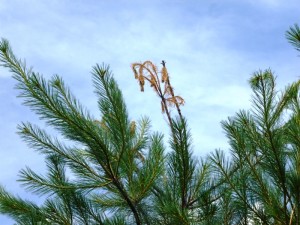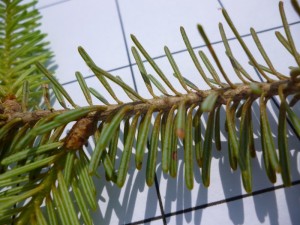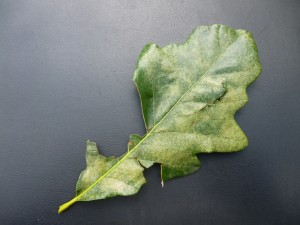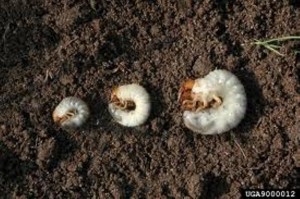Damage from previously active White Pine Weevil larvae (Pissodes strobi) has been evident for the past several weeks on Eastern white pine, Norway spruce, Siberian spruce, Colorado blue spruce, & Douglas-fir. The larvae began feeding within the terminal leaders last April. When the terminal leader is heavily infested, larvae feed side by side in a ring encircling the stem. By late spring or early summer, most White Pine Weevil larvae have pupated & emerged as adults. The terminal leader has become stunted and wilted. It is too late in the season to save the leader and it should be pruned out. To re-establish a new leader and retain the desirable Christmas tree shape read further & follow the procedures suggested.
Black Vine Weevil Best Treatment Window Nearing End in NJ
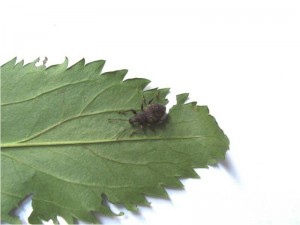
Black Vine Weevil Adults Are Noctural and Cause Feeding Damage at Night. Proto Credit: Steven K. Rettke of RCE
Many landscape & nursery managers consistently state that attempting to manage the black vine weevil insect (Otiorhynchus subcatus) as one of the most problematic pests they encounter. These leaf notching weevils feed on many kinds of ornamental plants including yews, rhododendrons, azaleas, laurels, leucothoe, forsythia, euonymus, hollies, viburnum, most deciduous and evergreen shrubs, ground covers and many kinds of perennials and annuals.
Controlling Black Vine Weevil adults during the month of June will prevent egg laying during the weeks of July. This beetle only has one generation a year.
Cool Season Mites Wax as the Warm Season Mites Wane
In the New Jersey region, the late weeks of September & early weeks of October are transition periods for warm season & cool season spider mite species found in landscapes & nurseries. The spruce spider mite & the southern red spider mite are the most common cool season species & they are now “waking-up” from their summer inactive period. Alternatively, the warm season two-spotted spider mite may have stopped feeding or will soon cease. They are rapidly declining & preparing to depart the leaves of their host plants if they have not already done so.
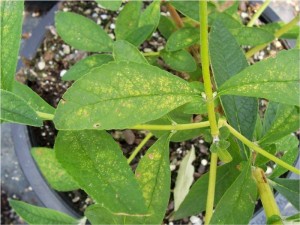
Two-spotted spider mites that produced these stippling symptoms on burning bush this summer are now entering dormancy with the arrival of autumn
(Photo: Steven K. Rettke of RCE)
Magnolia and Tuliptree Scales: Two Exceptions to the Rule
Magnolia Scales (Neolecanium cornuparvum) & Tuliptree Scales (Toumeyella liriodendri) are both classified within the soft scale group. However, unlike essentially all the other soft scale species they have crawler emergence in August & September instead of in June & July. This fundamental difference is important to recognize in order to time sprays & achieve best controls.
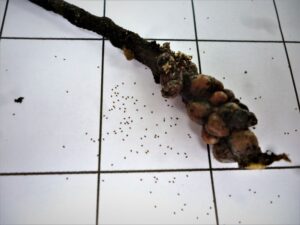
Hatched 1st instar magnolia scale crawlers knocked-off branch onto white paper. (Photo Credit: Steven K. Rettke, Rutgers Coop. Ext.)
Oak Lace Bug Symptoms Have Bark, But They Have Little Bite
During the weeks of summer, the symptoms caused by Oak Lace Bugs (Corythucha arcuata) can be a concern to some landscapers & nurserymen. Often times, the infestations are most pronounced on white oaks. From a distance, the stippling of leaves from this piecing-sucking insect can produce symptoms that are similar to those from oak spider mites or classic leaf scorch. Closer inspection determines the identity of the pest.
Oriental Beetle Treatment Window Closes for NJ Nurseries
In most areas of NJ, the application timing of imidacloprid to nursery containers to achieve best efficacy against Oriental beetle grubs (Anomala orientalis) has now expired. The majority of eggs are laid during late June through early July and by the time August arrives, many of the grubs will have begun to molt into the 2nd instar stage. If imidacloprid is not applied until August, then some root feeding damage may have already occurred & furthermore, the larger instars will be more difficult to control. Generally, the preventative applications should be applied from early June to mid-July to achieve best results.
Next year, some nurseries may want to attempt the new Oriental beetle mating disruption pheromone that is discussed in the second half of this article.
